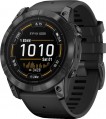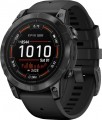Add to comparison |  |  |
|---|---|---|
| Garmin Epix Pro Gen 2 51mm | Garmin Epix Pro Gen 2 47mm | |
| Compare prices 4 | Compare prices 4 | |
| TOP sellers | ||
Advanced training and recovery metrics. Connect to Connect IQ via Wi-Fi (download TopoActive maps, watch faces, etc.). Touch screen in all parts of the interface. Autonomy optimization with multi-frequency GPS with Satiq technology. Differences from standard versions: the presence of a flashlight, 32 GB of memory and multi-frequency GPS in all modifications; new optical heart rate sensor Garmin Elevate V5, fast charging (~60 min instead of 120 min). In the Pro version, the case is available in 3 sizes (like Fenix). | Advanced training and recovery metrics. Connect to Connect IQ via Wi-Fi (download TopoActive maps, watch faces, etc.). Touch screen in all parts of the interface. Autonomy optimization with multi-frequency GPS with Satiq technology. Differences from standard versions: the presence of a flashlight, 32 GB of memory and multi-frequency GPS in all modifications; new optical heart rate sensor Garmin Elevate V5, fast charging (~60 min instead of 120 min). In the Pro version, the case is available in 3 sizes (like Fenix). | |
| Type | smartwatch | smartwatch |
| Interface | Bluetooth v 5.0 | Bluetooth v 5.0 |
| ANT+ | ||
Telephony | ||
| Calls and alerts | notifications sound signal vibration | notifications sound signal vibration |
Sports and tourism | ||
| Possible measurements | heart rate monitor blood oxygen level ambient temperature number of steps distance traveled movement speed calories burned activity time sleep tracking stress level women's calendar | heart rate monitor blood oxygen level ambient temperature number of steps distance traveled movement speed calories burned activity time sleep tracking stress level women's calendar |
| Swimming mode | ||
| Navigation | GPS module GLONASS Galileo maps GPS track guidance compass altimeter (altitude) barometer (pressure) | GPS module GLONASS Galileo maps GPS track guidance compass altimeter (altitude) barometer (pressure) |
Display | ||
| Touch screen | ||
| Type | colour | colour |
| Display type | AMOLED | AMOLED |
| Size | 1.4 " | 1.3 " |
| Screen resolution | 454x454 px | 416x416 px |
| PPI | 324 ppi | 320 ppi |
| Watch face protection | Gorilla Glass | Gorilla Glass |
Hardware | ||
| Memory storage | 32 GB | 32 GB |
| Extra features | built-in player light sensor Wi-Fi NFC Garmin Pay contactless payment accelerometer gyroscope full-fledged flashlight | built-in player light sensor Wi-Fi NFC Garmin Pay contactless payment accelerometer gyroscope full-fledged flashlight |
Power source | ||
| Device charging | proprietary connector | proprietary connector |
| Source of power | Li-Ion | Li-Ion |
| Operating time (normal mode) | 31 days | 16 days |
| Battery life (GPS) | 82 h | 42 h |
Case and strap | ||
| Material | plastic | plastic |
| Strap | quick release | quick release |
| Strap Options | rubber/silicone | rubber/silicone |
| Clasp options | classic buckle | classic buckle |
| Band Width | 26 mm | 22 mm |
| Wrist strap | silicone: 127 – 210, leather: 135 – 213, fabric: 135 – 213, metal: 135 – 225 mm | silicone: 125 – 208, leather: 132 – 210, fabric: 132 – 210, metal: 132 – 215 mm |
General | ||
| Protection rating | 100 WR (10 ATM) | 100 WR (10 ATM) |
| MIL-STD-810 | ||
| Dimensions (without strap) | 51x51x14.9 mm | 47x47x14.5 mm |
| Weight | 98 g | 78 g |
| Color | ||
| Added to E-Catalog | june 2023 | june 2023 |